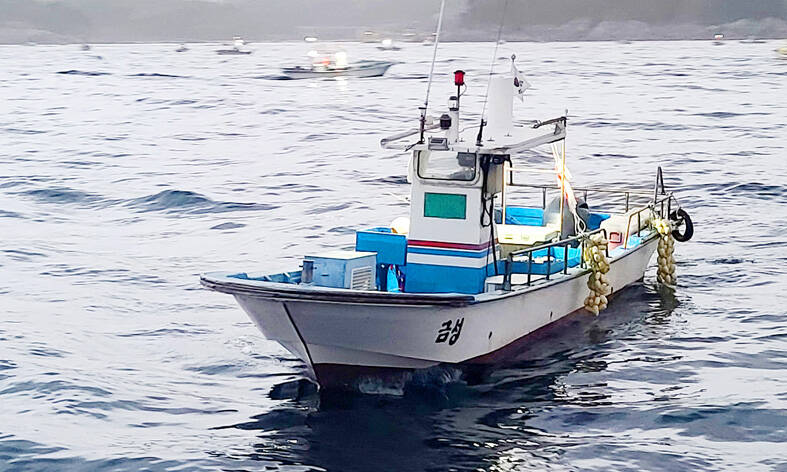The South Korean military yesterday said it had fired warning shots to repel a North Korean patrol vessel that temporarily crossed the countries’ disputed western sea boundary while chasing a Chinese fishing boat.
The North Korean patrol boat crossed the so-called Northern Limit Line at about 11am on Saturday while pursuing the Chinese boat in waters near South Korea’s Baekryeong Island, but immediately retreated after a South Korean naval vessel fired warning shots, the South Korean Joint Chiefs of Staff said.
While there were no exchanges of fire between the North and South Korean vessels, the South Korean high-speed vessel collided with the Chinese boat as it responded to the intrusion amid poor visibility, causing bruises and other minor injuries to some of the South Korean sailors.

Photo: EPA-EFE
The Joint Chiefs of Staff said that the South Korean military is closely monitoring North Korean military activities while preparing for various possibilities of provocation.
The South Korean navy has often fired warning shots to repel North Korean vessels crossing the countries’ poorly marked sea border, but there also have been some deadly clashes over the past decades. South Korea blamed North Korea for an attack on a South Korean warship that killed 46 sailors in 2010, but Pyongyang has denied responsibility.
Saturday’s intrusion came amid heightened tensions in the region as the pace of North Korea’s weapons demonstrations and the US-South Korean joint military exercises aimed at countering the North Korean threat have intensified in a cycle of tit-for-tat.
The South Korean and US militaries are conducting another large-scale joint exercise from next week, involving about 110 warplanes, including advanced F-35 fighter jets.
‘JOINT DEFENSE POSTURE’
The South Korean Ministry of National Defense said the aerial drills, which begin today and continue through Friday next week, are aimed at sharpening combined operational abilities and demonstrating the allies’ joint defense posture in the face of North Korean threats.
North Korea last week staged one of its most provocative military displays in the past few years by test firing what it described as a solid-fuel intercontinental ballistic missile, which, if perfected, could potentially give the North a more powerful and harder-to-detect weapon targeting the mainland US.
South Korean officials also say North Korea has not been responding to South Korean calls on a set of cross-border inter-Korean hotlines for more than a week, which raises concerns about potential kinetic provocations, as communications on those channels are meant to prevent accidental clashes along the sea border.

‘UNUSUAL EVENT’: The Australian defense minister said that the Chinese navy task group was entitled to be where it was, but Australia would be watching it closely The Australian and New Zealand militaries were monitoring three Chinese warships moving unusually far south along Australia’s east coast on an unknown mission, officials said yesterday. The Australian government a week ago said that the warships had traveled through Southeast Asia and the Coral Sea, and were approaching northeast Australia. Australian Minister for Defence Richard Marles yesterday said that the Chinese ships — the Hengyang naval frigate, the Zunyi cruiser and the Weishanhu replenishment vessel — were “off the east coast of Australia.” Defense officials did not respond to a request for comment on a Financial Times report that the task group from

Asian perspectives of the US have shifted from a country once perceived as a force of “moral legitimacy” to something akin to “a landlord seeking rent,” Singaporean Minister for Defence Ng Eng Hen (黃永宏) said on the sidelines of an international security meeting. Ng said in a round-table discussion at the Munich Security Conference in Germany that assumptions undertaken in the years after the end of World War II have fundamentally changed. One example is that from the time of former US president John F. Kennedy’s inaugural address more than 60 years ago, the image of the US was of a country

BLIND COST CUTTING: A DOGE push to lay off 2,000 energy department workers resulted in hundreds of staff at a nuclear security agency being fired — then ‘unfired’ US President Donald Trump’s administration has halted the firings of hundreds of federal employees who were tasked with working on the nation’s nuclear weapons programs, in an about-face that has left workers confused and experts cautioning that the Department of Government Efficiency’s (DOGE’s) blind cost cutting would put communities at risk. Three US officials who spoke to The Associated Press said up to 350 employees at the National Nuclear Security Administration (NNSA) were abruptly laid off late on Thursday, with some losing access to e-mail before they’d learned they were fired, only to try to enter their offices on Friday morning

CONFIDENT ON DEAL: ‘Ukraine wants a seat at the table, but wouldn’t the people of Ukraine have a say? It’s been a long time since an election, the US president said US President Donald Trump on Tuesday criticized Ukrainian President Volodymyr Zelenskiy and added that he was more confident of a deal to end the war after US-Russia talks. Trump increased pressure on Zelenskiy to hold elections and chided him for complaining about being frozen out of talks in Saudi Arabia. The US president also suggested that he could meet Russian President Vladimir Putin before the end of the month as Washington overhauls its stance toward Russia. “I’m very disappointed, I hear that they’re upset about not having a seat,” Trump told reporters at his Mar-a-Lago resort in Florida when asked about the Ukrainian